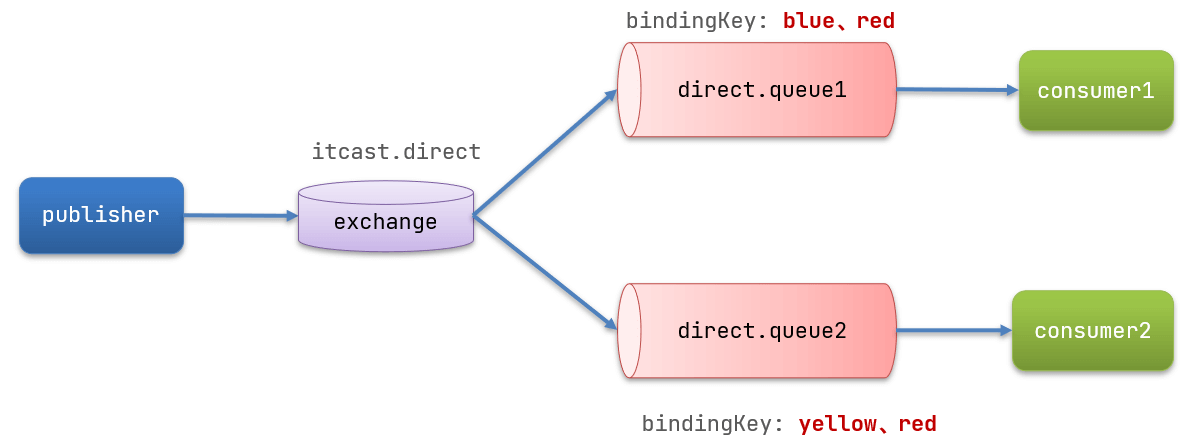在Fanout模式中,一条消息,会被所有订阅的队列都消费。但是,在某些场景下,我们希望消息被指定的队列消费。这时就要用到Direct类型的Exchange。
在Direct模型下:
- 队列与交换机的绑定,不能是任意绑定了,而是要指定一个
RoutingKey(路由key) - 消息的发送方在 向 Exchange发送消息时,也必须指定消息的
RoutingKey。 - Exchange不再把消息交给每一个绑定的队列,而是根据消息的
RoutingKey进行判断,只有队列的Routingkey与消息的Routingkey完全一致,才会接收到消息。
案例
- 利用@RabbitListener声明Exchange、Queue、RoutingKey
- 在consumer服务中,编写两个消费者方法,分别监听direct.queue1和direct.queue2
- 在publisher中编写测试方法,向itcast. direct发送消息
1.引入依赖
2.基于注解声明交换机和队列并接收消息
基于@Bean的方式声明队列和交换机比较麻烦,Spring还提供了基于注解方式来声明。
在consumer的SpringRabbitListener中添加两个消费者,同时基于注解来声明队列和交换机:
package cn.itcast.mq.listener;import org.springframework.amqp.core.ExchangeTypes;import org.springframework.amqp.rabbit.annotation.Exchange;import org.springframework.amqp.rabbit.annotation.Queue;import org.springframework.amqp.rabbit.annotation.QueueBinding;import org.springframework.amqp.rabbit.annotation.RabbitListener;import org.springframework.stereotype.Component;@Componentpublic class SpringRabbitListener {@RabbitListener(bindings = @QueueBinding(value = @Queue(name = "direct.queue1"),exchange = @Exchange(name = "itcast.direct", type = ExchangeTypes.DIRECT),key = {"red", "blue"}))public void listenDirectQueue1(String msg){System.out.println("消费者接收到direct.queue1的消息:【" + msg + "】");}@RabbitListener(bindings = @QueueBinding(value = @Queue(name = "direct.queue2"),exchange = @Exchange(name = "itcast.direct", type = ExchangeTypes.DIRECT),key = {"red", "yellow"}))public void listenDirectQueue2(String msg){System.out.println("消费者接收到direct.queue2的消息:【" + msg + "】");}}
3.发送消息
在publisher服务的SpringAmqpTest类中添加测试方法:
@Testpublic void testSendDirectExchange() {// 交换机名称String exchangeName = "itcast.direct";// 消息String message = "红色警报!日本乱排核废水,导致海洋生物变异,惊现哥斯拉!";// 发送消息rabbitTemplate.convertAndSend(exchangeName, "red", message);}
因为两个队列都绑定了red的key,所以发消息给带有red key的队列,两个消费者都能拿到消息


